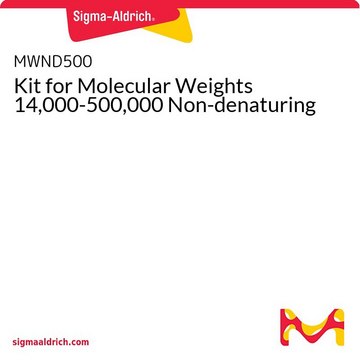M3546
Ultra-low Range Molecular Weight Marker (M.W. 1,060-26,600)
Sinónimos:
protein markers, protein molecular weight markers, protein standards
About This Item
Productos recomendados
uso
vial sufficient for 400 applications on large gels (16 × 18 cm)
vial sufficient for 800 mini-gels (10 × 10 cm)
Nivel de calidad
100
200
envase
vial of 200 μL
temp. de almacenamiento
−20°C
Aplicación
Acciones bioquímicas o fisiológicas
Forma física
Producto relacionado
Palabra de señalización
Danger
Frases de peligro
Consejos de prudencia
Clasificaciones de peligro
Acute Tox. 4 Dermal - Aquatic Chronic 3 - Eye Dam. 1 - Repr. 2 - Skin Sens. 1
Código de clase de almacenamiento
10 - Combustible liquids
Punto de inflamabilidad (°F)
Not applicable
Punto de inflamabilidad (°C)
Not applicable
Certificados de análisis (COA)
Busque Certificados de análisis (COA) introduciendo el número de lote del producto. Los números de lote se encuentran en la etiqueta del producto después de las palabras «Lot» o «Batch»
¿Ya tiene este producto?
Encuentre la documentación para los productos que ha comprado recientemente en la Biblioteca de documentos.
Los clientes también vieron
Protocolos
Separation of Polyacrylic acid (PAA) 438 kDa; Polyacrylic acid (PAA) 235 kDa; Polyethylenimine (PEI) 266 kDa ; Poly(dimethyl diallyl ammonium chloride) (PIDADMACl) 204 kDa; p-Aminosalicylic acid (PAS) 7800 Da; p-Aminosalicylic acid (PAS) 257 kDa; Cationic dextran (11 kDa); Chitosan (13.4 kDa)
Nuestro equipo de científicos tiene experiencia en todas las áreas de investigación: Ciencias de la vida, Ciencia de los materiales, Síntesis química, Cromatografía, Analítica y muchas otras.
Póngase en contacto con el Servicio técnico













